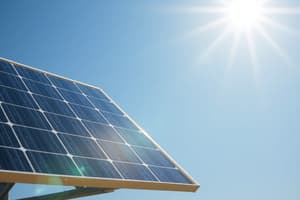Podcast
Questions and Answers
What is the primary source of light energy that reaches us?
What is the primary source of light energy that reaches us?
The sun
What is the term used to describe the movement of a wave in physics?
What is the term used to describe the movement of a wave in physics?
Propagate
What is the definition of a medium in the context of waves?
What is the definition of a medium in the context of waves?
Any material that can be disturbed and then return to an equilibrium state
What is the difference between a pulse wave and a periodic wave?
What is the difference between a pulse wave and a periodic wave?
What is the symbol for wavelength, and what does it represent?
What is the symbol for wavelength, and what does it represent?
What is the particle theory of light, and how does it describe light behavior?
What is the particle theory of light, and how does it describe light behavior?
What is the wave theory of light, and who proposed it?
What is the wave theory of light, and who proposed it?
What is the term used to describe the number of waves passing a point in a given time?
What is the term used to describe the number of waves passing a point in a given time?
What is the relationship between the frequency of a wave and its wavelength, and how does this relationship affect the energy of the wave?
What is the relationship between the frequency of a wave and its wavelength, and how does this relationship affect the energy of the wave?
What is the mathematical relationship between frequency and period, and how do changes in one affect the other?
What is the mathematical relationship between frequency and period, and how do changes in one affect the other?
What is the characteristic of light that allows it to travel in empty space, and what is the name of this property?
What is the characteristic of light that allows it to travel in empty space, and what is the name of this property?
What is the difference between low, medium, and high frequency waves in terms of wavelength, period, and energy?
What is the difference between low, medium, and high frequency waves in terms of wavelength, period, and energy?
What is the effect of increasing the number of wave crests per second on the frequency and wavelength of a wave?
What is the effect of increasing the number of wave crests per second on the frequency and wavelength of a wave?
What is the relationship between the energy of a wave and its frequency, and how does this relationship affect the wavelength?
What is the relationship between the energy of a wave and its frequency, and how does this relationship affect the wavelength?
What is the characteristic of light that allows it to travel in straight lines, and what is the name of this property?
What is the characteristic of light that allows it to travel in straight lines, and what is the name of this property?
What is the reason why we cannot see light as it travels through air, and how can we detect its presence?
What is the reason why we cannot see light as it travels through air, and how can we detect its presence?
Flashcards are hidden until you start studying
Study Notes
Light Energy
- Light energy reaches us from the sun in the form of solar radiation.
- To reach us, light has to travel through space, which is a vacuum.
Theories of Light
- There are two main theories of light: the "particle" theory and the "wave" theory.
- The "particle" theory states that light is expressed as a stream of tiny particles called photons.
- The "wave" theory states that light is expressed as waves and can be described by the term light wave.
Waves
- A wave is any disturbance in a medium that propagates through the medium.
- The term propagate is used to describe wave movement in physics.
- A medium is any material that can be disturbed, such as a fluid (liquid or gas) or a solid.
Types of Waves
- Pulse wave: a single disturbance that only assaults the medium once.
- Periodic wave: a disturbance that repeatedly disturbs the medium, with characteristics such as frequency, period, and wavelength.
Wave Characteristics
- Wavelength (λ): the distance over which a wavelength repeats itself, measured in meters.
- Frequency (f): the number of waves passing a point in a given time, measured in hertz (Hz) or cycles per unit.
- Relationship between frequency and wavelength: as frequency increases, wavelength decreases, and vice versa.
- Energy input: as more energy is inputted to creating a wave, the frequency increases, and the wavelength decreases.
Frequency Levels
- Low Frequency: longer wavelength, longer period, carries less energy.
- Medium Frequency: shorter wavelength, decreased period, greater energy.
- High Frequency: shortest wavelength, lowest period, greatest energy.
Period
- Period (T): measures how long it takes for a wave to pass a given point in its entirety, from crest to crest.
- Mathematical relationship between frequency and period: frequency x period = 1, therefore, if frequency increases, period must decrease.
Properties of Light
- Light requires no medium to travel, and thus can travel in empty space.
- Light travels in straight lines as long as the composition of the medium remains constant (linear propagation).
- Light is invisible when it travels through a vacuum or a transparent substance, and can only be detected by its effects.
Studying That Suits You
Use AI to generate personalized quizzes and flashcards to suit your learning preferences.




